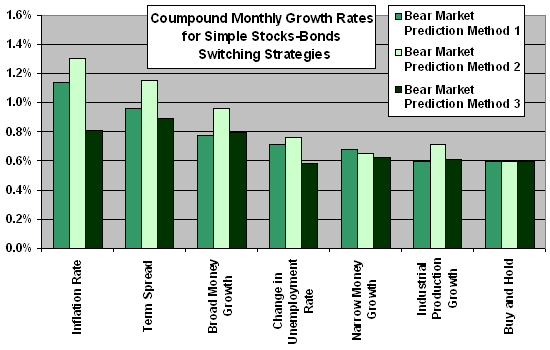Is it possible to predict bear markets for stocks using macroeconomic indicators? In his March 2008 paper entitled “Predicting the Bear Stock Market: Macroeconomic Variables as Leading Indicators”, Shiu-Sheng Chen investigates whether macroeconomic variables such as interest rate term spread, inflation rate, money supply, aggregate output and unemployment rate can individually predict equity bear markets both in-sample and out-of-sample. Using monthly S&P 500 index data and macroeconomic data for the period February 1957 through December 2007, he concludes that:
- High-return stable (bull) and low-return volatile (bear) market states persist on average for 20 months and 6.7 months, respectively.
- The term spread (short-term yield minus long-term yield), inflation rate and unemployment rate relate positively to the probability of a bear market. Industrial production growth relates negatively.
- The yield curve spread and the inflation rate are the most useful predictors of bear markets for U.S. stocks, both in-sample and out-of-sample, with roughly equal accuracy. The term spread (inflation rate) is more accurate beyond six months (within three months). The other macroeconomic variables are short-term predictors.
- It is generally easier to predict bear markets than stock returns using macroeconomic variables. Only a few variables at particular horizons have predictive power for stock returns.
- A simple out-of-sample switching strategy that holds stocks (bonds) when the probability of a bear market one month later based on the yield curve or the inflation rate is less than (greater than) 30% substantially outperforms a benchmark buy-and-hold strategy. (See the chart below.)
The following chart, constructed from data in the paper, compares the compound monthly returns (before transaction costs) generated by switching strategies derived from three distinct ways of using individual macroeconomic indictors to predict bear markets. Each strategy, over the period March 1967 through December 2007, holds the S&P 500 index when the probability of a bear market the next month is less than 30% and bonds otherwise. Results indicate that some macroeconomic indicators support switching strategies that substantially beat a buy-and-hold strategy.

In summary, investors may be able to exploit the predictive power of the inflation rate and the yield curve to “switch out” of bear markets and thereby beat a buy-and-hold approach.